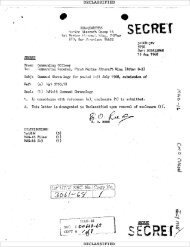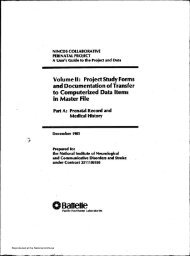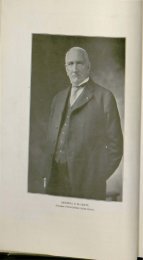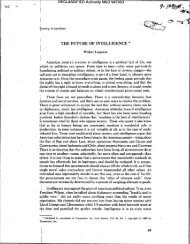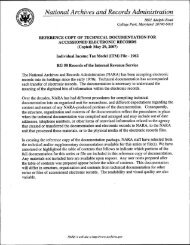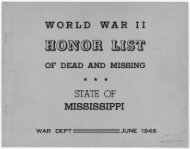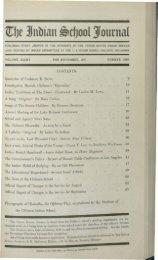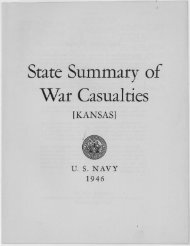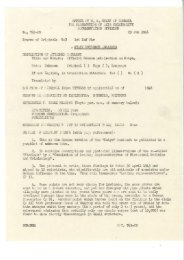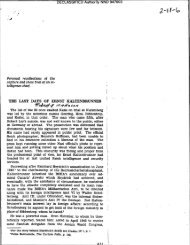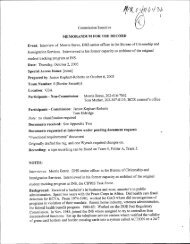Part IV. C. 7. b. - National Archives and Records Administration
Part IV. C. 7. b. - National Archives and Records Administration
Part IV. C. 7. b. - National Archives and Records Administration
You also want an ePaper? Increase the reach of your titles
YUMPU automatically turns print PDFs into web optimized ePapers that Google loves.
Declassified per Executi ve Order 13526, Section 3.3<br />
NND Project Number: NND 63316. By: NWD Date: 2011<br />
<strong>IV</strong>.C Evolution of the War (26 Vols.)<br />
Direct Action: The Johnson Commitments, 1964-1968<br />
(16 Vols.)<br />
<strong>7.</strong> Air War in the North: 1965 -1968 (2 Vols.)<br />
b. Volume II
Declassified per Executi ve Order 13526, Section 3.3<br />
NND Project Number: NND 63316. By: NWD Date: 2011
"<br />
Declassified per Executive Order 13526, Section 3.3<br />
NND Project Number: NND 63316, By: NWD Date: 2011<br />
TOP SECRET - Sensitive<br />
<strong>IV</strong>. C. <strong>7.</strong> (b)<br />
Volume II<br />
THE AIR I'JAR IN NORTH VIE'l'NA.M<br />
0 295<br />
, Sec IDe! Cant Nr. X-_____________ _<br />
TOP SECRET - Sensitive
Declassified per Executi ve Order 13526, Section 3.3<br />
NND Project Number: NND 63316. By: NWD Date: 2011
Declassified per Executive Order 13526, Section 3.3<br />
NND Project Number: NND 63316. By: NWD Date: 2011<br />
TOP SECRET - Sensitive<br />
The discussion section of the paper dealt with each of<br />
the eight specific option areas noting our capability in each instance<br />
to inflict heavy damage or complete destruction to the facilities in<br />
question. The important conclusion in each instance >-ras that elimination<br />
of the targets, individually or collectively, could not sufficiently<br />
reduce the flolv of men <strong>and</strong> materiel to the South to undercut the Communist<br />
forces fighting the war . The inescapable fact which forced this conclusion<br />
was that North Vietnam' s import potential far exceeded its requirements<br />
<strong>and</strong> cotud sustain considerable contraction without impairing the war<br />
effort . The point was dramatically made in the follo>-ring table:<br />
When Option 4 is taken together with Options 1-3, the<br />
i mport <strong>and</strong> need figures appear as follo,vs :<br />
NORTH VIETNAM ' S POTETIITIAL FOR OBTAINING<br />
I MPORTS BEFORE AND AF'rER U. S. ATTACK<br />
(tons per day)<br />
Potential NOliT potential After Attack<br />
By sea 6,500 650<br />
By Red River from China 1,500 150<br />
By road from China 3,200 2,400<br />
By rail from China 6,000 4,000<br />
TOTAL 17,200 7,200<br />
Without major hardship, the need for imports is as follo>-Ts (tons<br />
per day):<br />
Normal imports<br />
If imports replace destroyed i ndustrial production<br />
If imports r eplace rice destroyed by leveee breaks<br />
TOTAL<br />
4,200<br />
1,400<br />
600-2,500<br />
6,200-8,100 12.1<br />
With respect to crippling Hanoi ' s will to continue the war,<br />
the paper stated:<br />
Unless things were going very badly for t hem there<br />
/J-n the So"ut'i/, it is likely that the North Vietnamese<br />
would decide to continue the war despite their concern over<br />
the increasing destruction of their country, t he effect of<br />
this on their people , <strong>and</strong> their i ncreasing apprehensi on<br />
that the US would invade the North. ]£I<br />
11 TOP SECRET - Sensitive
Declassified per Executive Order 13526, Section 3.3<br />
NND Project Number: NND 63316. By: NWD Date: 2011<br />
TOP SECRET - Sensitive<br />
In a similar fashion Bundy developed his arguments against a major<br />
increase in U.S. troop strength in the South <strong>and</strong> urged the President<br />
not to take any nevr diplomatic initiatives for the present . But the<br />
appeal of Bundy ' s analysis for the President must surely have been its<br />
finale in which Bundy, acutely avrare of the F:esident ' s political<br />
sensitivities , cast his arguments in the context of the forthcoming<br />
1968 Presidential elections. Here is how he presented the case:<br />
There is one further argument against major escalation<br />
i n 1967 <strong>and</strong> 1968 "Thich is 'Ivorth stating separately, because<br />
on the surface it seems cynically political. It is that<br />
Hanoi i s going to do everything it possibly can to keep its<br />
position intact until after our 1968 elections . Given their<br />
history, they are bound to hold out for a possible U.S. shift<br />
in 1969 -- that's Ivhat they did against the French, <strong>and</strong> they<br />
got most of vThat they wanted when Mendes took po'\ver . Having<br />
held on so long this time , <strong>and</strong> having nothing much left to<br />
l ose -- compared to the chance of victory -- they are bound to<br />
keep on fighting . Since only atornic bomb s could really knock<br />
them out (an invasion of North Vietnam would not do it in<br />
tl'TO years, <strong>and</strong> is of course ruled out on other grounds) , they<br />
have it in their p01',ver to "prove" that military escalation<br />
does not bring peace - - at least over the next two years .<br />
They vTill surely do just that. However much they may be<br />
hurting, they are not going to do us any favors before<br />
November 1968 . (And since this was drafted, they have been<br />
publicly advised by Walter Lippmann to wait for the Republicans<br />
as if they needed the advice <strong>and</strong> as if it was his place to give<br />
it! )<br />
It follo,vs that escalation '\vill not bring visible victory<br />
over Hanoi before the election. Therefore the election will<br />
have to be fought by the <strong>Administration</strong> on other grounds .<br />
I think those other grounds are clear <strong>and</strong> i mportant, <strong>and</strong> that<br />
t hey will be ob scured if our policy is thought to be one of<br />
increasing -- <strong>and</strong> ineffective -- military pressure.<br />
If vTe assume that the war will still be going on in<br />
November 1968, <strong>and</strong> that Hanoi Ivill not give us the pleasure<br />
of consenting to negotiations sometime before then what we<br />
must plan to offer as a defense of <strong>Administration</strong> policy is<br />
not victory over Hanoi, but growing success -- <strong>and</strong> selfreliance<br />
-- in the South. This we can do , with luck, <strong>and</strong> on<br />
this side ,)f the parallel the Vietnamese authorities should be<br />
prepared to help us out (though of course the VC will do their<br />
damnedest against us.) Large parts of Westy ' s speech (if not<br />
quite all of it) i.,rere lv-holly consistent with this line of argument<br />
. 111<br />
28 TOP SECRET - Sensitive
Declassified per Executi ve Order 13526, Section 3.3<br />
NND Project Number: NND 63316. By: NWD Date: 2011<br />
TOP SECRET - Sensitive<br />
A. Closing the top of the funnel<br />
Under this strategy v.Te vlOuld mine the major harbors <strong>and</strong>,<br />
perhaps, bomb port facilities <strong>and</strong> even consider blockade.<br />
In addition, w'e would attack systematically the rail lines<br />
between Hanoi <strong>and</strong> mainl<strong>and</strong> China. At the moment the total<br />
import capacity into North Viet Nam is about 17,200 tons<br />
per day. :E,'ven with exp<strong>and</strong>ed import req,uirement due to<br />
the food shortage, imports are, in fact, coming in at about<br />
5700 tons per day. It is possible with a concerted <strong>and</strong><br />
determined effort that Tde could cut back import capacity<br />
somei'That below the level of req,uirements ; but this is not<br />
sure. On the other h<strong>and</strong>, it 'ivould req,uire a difficult <strong>and</strong><br />
sustained effort by North Viet Nam <strong>and</strong> its allies to prevent<br />
a reduction in total imports below req,uirements if v.Te<br />
did all these things.<br />
The costs 'ivould be these:<br />
--The Soviet Union would have to pennit .a radical increase<br />
in Hanoi I s dependence upon Comrnu..l1ist China, or introduce<br />
minesweepers, etc., to keep its supplies coming into Hanoi<br />
by sea;<br />
--The Chinese Communists would probably introduce<br />
many more engineering <strong>and</strong> anti-aircraf't forces along the<br />
roads <strong>and</strong> rail lines betlveen Hanoi <strong>and</strong> China in order to<br />
keep the supplies moving;<br />
- -To maintain its prestige, in case it cOlud not or<br />
would not open up HanOi-Haiphong in the face of mines, the<br />
Soviet Union might contemplate creating a Berlin crisis .<br />
Hith respect to a Berlin crisis, they v.wuld have to weigh<br />
the possible split between the U. S. <strong>and</strong> its Hestern European<br />
allies under this pressure against damage to the atmosphere<br />
of detente in :E,urope vlhich is working in favor of the French<br />
Communist <strong>Part</strong>y <strong>and</strong> providing the Soviet Union with generall y<br />
enlarged influence in Hestern EurGpe .<br />
I myself do not believe that the Soviet Union would go<br />
to 'Har with us over Viet Nam unless we sought to occupy<br />
North Viet Nam; <strong>and</strong>, even then, a military response from<br />
MOSCov.T vlould not be certain.<br />
Hi th respect to Communist China, it always has the<br />
option of invading laos <strong>and</strong> Thail<strong>and</strong>; but this ,volud not<br />
be a rational response to nava.l <strong>and</strong> air operations designed<br />
to strangle Hanoi. A war .througbout Southeast Asia 'ivould<br />
not help Hanoi; altholJgh I do believe Communist China 'ilould<br />
'I'OP SECRET - Sensitive
. .<br />
Declassified per Executive Order 13526, Section 3.3<br />
NND Project Number: NND 63316. By: NWD Date: 2011<br />
TOP SECRET - Sensitive<br />
fight us if we invaded.the northern part of North Viet Nam.<br />
One can ahrays take the vie"r that, given the tUrmoil<br />
inside Communist China, an irrational act by Peiping is<br />
possible. And such irrationality cannot be ruled out.<br />
I conclude that if \·re try to close the top of the<br />
funnel, tension bet,qeen ourselves <strong>and</strong> the Soviet Union<br />
<strong>and</strong> Com..munist China would increase; if we were very determined,<br />
we could impose additional burdens on Hanoi <strong>and</strong> its<br />
allies; we might cut capacity below' requirements; <strong>and</strong> the<br />
outcome is less likely to be a general "\-Tar than more likely.<br />
B . Attacking I'That is inside the funnel<br />
This is what ,ve have been doing in the Hanoi-Ha:i.phong<br />
area for some ,-reeks. I . do not agree "lv:i. th the view that the<br />
attacks on Hanoi-Haiphong have no bearing on the war in the<br />
South. They divert massive amounts of resources , energies , <strong>and</strong><br />
attention to keeping the civil <strong>and</strong> military establishment<br />
going . They i mpose general economic, political, <strong>and</strong> psychological<br />
difficulties on the North "rhich have been complicated<br />
this year by a bad harvest <strong>and</strong> food shortages. I do not<br />
believe that they "harden the will of the North. " In my<br />
judgment, up to this point, our bombing of the North has been<br />
. a painful additional cost they have thus far been "lvilling to<br />
bear to pursue their efforts in the South.<br />
On the other h<strong>and</strong> :<br />
- -There is no direct, immediate connection bet,qeen bombing<br />
the Hanoi-Haiphong area <strong>and</strong> the battle in the South;<br />
- -If ,o[e complete the attack on electric po"rer by taking<br />
out the Hanoi station -- which constitutes about 80% of the<br />
electric pOI·rer supply of the country no,·r operating - - "\·re<br />
will have hit most of the targets whose destruction imposes<br />
serious mil:i.tary-civil costs on the North .<br />
With respect to risk, it is unclear whether Soviet<br />
"rarnings a1:)out our bombing Hanoi-Haiphor.g represent decisions<br />
already taken or dec:i.s:i.ons \·rh:i.ch might be taken if we persist<br />
in banging ar,-ray in that area .<br />
It is my judgment that the Soviet react:i.on "Till continue<br />
to be addressed to the problem imposed on Hanoi by us; that is,<br />
they might introduce Soviet pilots as they did in the Korean<br />
Har; they might bring ground-to-ground missiles into North<br />
Viet Nc;un "I'lith the object of attacKing our vessels at sea <strong>and</strong><br />
35<br />
TOP SECRE'T' - Sensitive
Declassified per Executive Order 13526, Section 3.3<br />
NND Project Number: NND 63316. By: NWD Date: 2011<br />
TOP SECRET - Sensitive<br />
the Hanoi-Haiphong area <strong>and</strong> may have .decided -- or could<br />
shortly decide -- to introduce into North Viet Nam some<br />
surface-to-surface missiles.<br />
With respect to option C, I believe we should, ·Hhile<br />
keeping open the B option, concentrate our attacks to<br />
the maximum in Route Packages I <strong>and</strong> 2 ; <strong>and</strong>, in conducting<br />
Hanoi-Ha iphong attacks, we should do so only when the targets<br />
make sense . I do not expect dramatic results from increasing<br />
the ,veight of attack in Route Packages I <strong>and</strong> 2; but I believe<br />
ive are Hasting a good many pilots in the Hanoi-Haiphong area<br />
without commensurate results. The major objectives of<br />
maintaining the B option can be achieved at lower cost. 2!}j<br />
Although he had endorsed a strike on the Hanoi power plant, he r ejected<br />
any attack on the air fields in a terse, one sentence final paragra,ph,<br />
ItAir field attacks are only appropriate to the kind of sustained operations<br />
in the Hanoi-Haiphong area associated with option A."<br />
Two important menili ers of the Amninistration, McNaughton<br />
<strong>and</strong> Rostow, had thus lireighed in for confining the bombing to the panh<strong>and</strong>le<br />
under some formula or other. On Monday, May 8, presurnably before the<br />
policy meeting, William Bundy circulated a draft memo of his Oim ,,,bich<br />
pulled the problem apart <strong>and</strong> assembled the pieces in a very different<br />
';lay. Like the others , Bundy ' s draft started from the assumption that<br />
bombing decisions would be related to other decisions on the war for<br />
ivhich a consensus appeared to exist : pressing ahead with pacification;<br />
continued political progress in the South; <strong>and</strong> continued pressure on the<br />
North . To Bundy ' s I'ray of thinking there "Tere four broad target categories<br />
t hat could be combined into various bombing options :<br />
1. ItConcentration on supply routes. It This would comprise<br />
attacks on supply routes in the southern Hbottleneck"<br />
areas of North Vietnam, from the 20th parallel south.<br />
2. It Re-strikes . tt This would comprise attacks on targets<br />
already hit, including unless otherwise stated sensitive targets<br />
north of the 20th parallel <strong>and</strong> in <strong>and</strong> around Ifanoi/ Haiphong, which<br />
were hit in the last three weeks .<br />
3. ItAddi tional sensi ti ve t argets . It North of the 20th<br />
parallel, there are additional sensitive targets that have<br />
been on our recent lists, including Rolling Thunder 56 .<br />
Some are of lesser importance, some are clearly "extremely<br />
sensitive lt (category 4 belOW), but at l east three -- the<br />
Hanoi pO'iver station, the Red Ri.ver bridge, <strong>and</strong> the' Phuc Yen<br />
airfield - - could be said to round out the April progra..1U .<br />
These t hree are the essential targets included in this<br />
category 3·<br />
37<br />
TOP SECRET - Sensitive
Declassified per Executive Order 13526, Section 3.3<br />
NND Project Number: NND 63316. By: NWD Date: 2011<br />
TOP SECRET - Sensitive<br />
t hat go beyond the above bare-bones statement of' our<br />
. tlcommitment!t); some will insist that pressure, enough<br />
pressure, un the North can pay of'f or th..l.t we will have<br />
yielded a blue chip without exacting a price in exchange<br />
f'or our concentrating on interdiction; many will argue<br />
that denial of the larger number of' troops "Till prolong<br />
t he war, risk losing it <strong>and</strong> increase the casualties of'<br />
the Americans who are there; some w'illinsist that this<br />
course reveals weakness to which Mos cow will react with<br />
relief', contempt <strong>and</strong> reduced willingness to help, <strong>and</strong> to<br />
which Hanoi ,viII react by increased dem<strong>and</strong>s <strong>and</strong> truculence ;<br />
others will point to the difficulty of carrying the<br />
Koreans, Filipinos, Australians <strong>and</strong> Ne"\V Zeal<strong>and</strong>ers with us ;<br />
<strong>and</strong> there wiJ_l be those "Tho point out the possibility that<br />
the changed US tone may cause a tFrush f'or the exists" in<br />
Thail<strong>and</strong>, in Laos <strong>and</strong> especially inside South Vietnam,<br />
perhaps threatening cohesion of the government, morale of<br />
the army, <strong>and</strong> loss of support among the people . Not least<br />
will be the alleged impact on the reputation of the United<br />
States <strong>and</strong> of its President. Nevertheless, the dif'ficulties<br />
of this strategy are fel-Ter <strong>and</strong> smaller than the difficulties '<br />
of any other approach. 112/<br />
McNamara shol'Ted the draft to the President the same day it<br />
,'Tas completed, but there i s no record of' his reaction. 113/ It i s worth<br />
noting, however, that May 19 was the day that U.S. planes struck the<br />
Hanoi po"rer plant just one-mile north of the center of Hanoi . That the<br />
President did not promptly endorse the McNamara recommendations as he<br />
had on occasions in the past is not surprising. This time he faced a<br />
situation where the Chiefs were in ardent opposition to anything other<br />
t han a significant escalation of the "lar with a callup of reserves . This<br />
put them in direct opposition to McNamara <strong>and</strong> his aides <strong>and</strong> created a<br />
genuine policy dilemma for the President who had to consider the necessity<br />
of keeping the military !ton-board" i n any ne"r direction for the U. S. effort<br />
i n Southeast Asia .<br />
4. JCS, CIA <strong>and</strong> State Reactions<br />
I n the hlO vTeeks after McNamara I s DPM, t he Washington papermill<br />
must have broken all previous production records . The JCS in particular<br />
l iterally bombarded the Secretary with memor<strong>and</strong>a, many of which had<br />
voluminous annE;xes . Their direct comments 01. the DPM did not come until<br />
ten days after it was transmitted to the President . Before then, however,<br />
a-\'lare of the McNamara proposals , they fOTVrarded a number of' studies each<br />
of' vThich "ras the occasion to advance their O\Vll arguments f'or escalation.<br />
On May 20 , the Chiefs sent the Secretary tyro memos , one<br />
urging expansion of operations against North Vietnam (,vhi ch they req,uested<br />
.53<br />
TOP SECRET - Sensitive
Declassified per Executi ve Order 13526, Section 3.3<br />
NND Project Number: NND 63316. By: NWD Date: 2011<br />
TOP SECRET - Sensitive<br />
political .q,ctivity under the Constitution (as the reconciliation<br />
appeal now does) . This latter appears to be the<br />
position of the South Vietnamese Government, 'which- -as<br />
Tran Van Do has just stated in Geneva--argues that those<br />
sympathetic to the Northern system of gover nment should go<br />
North, \'Thile those prepared to accept the Southern system<br />
of government may stay in the South. Legally, the first<br />
alternative is sound, in that Southerners who ,-rent North<br />
in 1954 becarr!e for all legal <strong>and</strong> practical purposes Northern<br />
citizens <strong>and</strong> demonstrated their allegiance . But if the<br />
South Vietnamese prefer the second alternative, it is in<br />
fact exactly comparable to the r egroupment provisions of<br />
the 1954 Accords, <strong>and</strong> can legally be sustained. But in<br />
either case the point is that the South Vietnamese are not<br />
obliged' to accept as citizens people "'Those total pattern<br />
of conduct ShovTS that they would seek to overthrol'l the<br />
structure of government by force <strong>and</strong> violence. 133/<br />
The remainder of Bundy ' s comments ylere addressed to<br />
importance of this last pOint. The U.S. could not consider withdra'l-ring<br />
its forces until not only the North Vietnamese troops but also the regroupees<br />
had returned to the North. Nowhere in his comments does he specifically<br />
touch on the merits of the hlO military options, but his argu.rnents<br />
all seem to support the tougher of the tYlO choices (his earlier support<br />
of restricting the bombing thus seems paradoxical). He Ylq.S , it is clear,<br />
l ess concerned with immediate specific decisions on a military phase of<br />
the war than "ivi th the long term consequences of this maj or readjustment<br />
of American sights in Southeast Asia.<br />
The only other reaction on the DPM from the State Department<br />
was a belated memo from Katzenbach to Vance on June 8. Katzenbach ' s<br />
criticisms were more focused on specific language <strong>and</strong> conclusions than<br />
Bundy ' s . In general they did not rej ect the analysis of the DPM, hOi-lever.<br />
Hith respect to the bombing, Katzenbach observed that, " •.. we<br />
ought to consider concentrating on infiltration routes throughout North<br />
Viet- Naill <strong>and</strong> leaving 'strategic ' targets, particularly those in urban<br />
areas alone ." 134/ This departed slightly from the Bundy-RostoYl<br />
McNaughton thesis of confining the bomb ing to the panh<strong>and</strong>le infiltration<br />
net'fork. As to the DPM ' s effort to circums cribe U. S. obj ecti ve s in the<br />
war, Katz.enbacn achieved a new l ow in underst.atement , "I agree with the<br />
arguments for limited obj ect:i.ves . But these are not easy to define . " 135/<br />
In short, if the intent of the DOD draft had been to precipitate an<br />
<strong>Administration</strong>-Hide debate on the :f'u...l1damental issues of the U. S . invol vement<br />
, it had certainly achieved its purpose .<br />
61 TOP SECRET - Sensitive
Declassified per Executive Order 13526, Section 3.3<br />
NND Project Number: NND 63316. By: NWD Date: 2011<br />
TOP SECRET - Sensitive<br />
of mutual de-escalation, but it w'as more likely to be taken as a<br />
sign of U. S. vreaknes s <strong>and</strong> encourage Hanoi to take a still stronger<br />
st<strong>and</strong> . 151/<br />
Exp<strong>and</strong>ed armed reconnaissance in northern NVN, especially<br />
i f coupled .. rith denying or inhibiting importation through Haiphong,<br />
•.• Hould have a sUbstantial effect on NVN economy<br />
<strong>and</strong> l ogistic net <strong>and</strong> Hould • . • force enough additional<br />
diversion of resources to reduce j\iVN infiltration <strong>and</strong><br />
support. 152/<br />
However, closure of Haiphong - - which might not shut off all a ccess from<br />
the sea - - vwuld carry unacceptable risks of Hider vrar , an allout attack<br />
on the railroads <strong>and</strong> roads from China was preferable, <strong>and</strong> Hould still<br />
complicate NVN ' s logistic problems. still more preferable, on balance,<br />
"ras maintaining the present level of operations :<br />
Because closure of Haiphong is probably not acceptable ,<br />
vrhat "Tould othervrise be a reasonable price in terms of aircraft<br />
loss for greatly reducing the inflow along the northern<br />
roads <strong>and</strong> railroads becomes an unreasonable loss in the<br />
presence of a possible increase of sea import .•.• This option<br />
i s not , without Haiphong port denial, an optimum use of airpower<br />
. It i s a w'ar of attrition, forced by the risk of a<br />
wider v'rar or other actions by the Soviets if we do try to<br />
close Haiphorig . In that sense, it is analogous to the<br />
ground ,'Tar in the South ... • 153/<br />
On June 9, Secretary of the Air Force Bro'\Vl1 sent McNamara a supplemental<br />
memo in which he tried to make a case for interdiction bombing based on<br />
a statistical demonstration that it was the most important factor in<br />
explaining the difference betw'een uninterdicted infiltration capability<br />
<strong>and</strong> actual infiltration. 154/<br />
Thus , the responses to the SecDef' s quest ions on bomb i ng<br />
north versus south of the 20th parallel divided about evenly, wi th the<br />
JCS arid the Air Force strongly opposed to a cutback t o 20 0 <strong>and</strong> backing<br />
the more escalatory route, <strong>and</strong> the Navy <strong>and</strong> CIA concl udi ng that interdiction<br />
either north or south was a di fficult i f not impossi bl e goal but<br />
t hat a cutback would cost little.<br />
6. The June 12th DPM<br />
The Defense Department having fully expl ored the various air<br />
vTar options , attention wi thin the Administrati on again :f(:Cused on preparing<br />
a memor<strong>and</strong>um to the President, this time on strategy against North Vietnam<br />
alone . But other events <strong>and</strong> problems were interveni ng to consume the<br />
.66 TOP SECRET - Sensitive
•<br />
Declassified per Executi ve Order 13526, Section 3.3<br />
NND Project Number: NND 63316. By: NWD Date: 2011<br />
TOP SECRET - Sensitive<br />
of a Canadian proposal to exchange a bombing halt for a redemilitarization<br />
of the DMZ . The Chiefs adamantly opposed the idea as a totally inequitable<br />
t rade-off. We Ivould sacrifice a valuable negotiating blue chip vlithout<br />
commensurate gain (such as a cessation of DRV infiltration) . 175/ With<br />
no other promising prospects for a d:i.plomat:i.c break-through, there was<br />
l ·ittle reason on that score to suspend even a part of the bombing at that<br />
time .<br />
The only other event that might have influenced the Secretary'<br />
s thinking was his trip to Vietnam JuJ.y 7-12. With a decision on<br />
the add:i.tional ground forces to be sent to Vietnam narrowing down , the<br />
President sent McNamara to Saigon to review the matter with General<br />
Westmorel<strong>and</strong> <strong>and</strong> reach agreement on a figure Ivell belovT the 200, 000<br />
Westy had requested in March. As it turned out, the total new troops<br />
i n Program #5 were about 25,000. In the briefings the Secretary received<br />
in Saigon, the Ambassador spoke briefly about the need for an effective<br />
:i.nterdiction system which he hoped vIe vlould find in the barrier. He<br />
reiterated most of the points he had made to Rusk by wire in June . 176/<br />
CINCPAC 1 S briefing on the air war began with the nOvT st<strong>and</strong>a,rd self--justifications<br />
based on denied requests for escalation. The body of<br />
his presentation did contain some interesting new information, however .<br />
For instance, Admiral Sharp confirmed that the increased effort in the NE<br />
quadrant had not been at the expense of sorties elsewhere in North Vietnam<br />
or Laos. The decline in U.S. losses in the Red River valley was attributable<br />
in part to the declining effectiveness of North Vietnam' s MIG, SA-2 ,<br />
<strong>and</strong> AAA defenses. This in turn Ivas explained by better U. S. tactics , <strong>and</strong>,<br />
most importantly, nelV '\-Ieapons <strong>and</strong> equipment like the WALLEYE guided bomb ,<br />
the CBU- 24 cluster bomb , the MK-36 Destructor <strong>and</strong> a much improved ECM<br />
capability. The rest of his presentation was given over to complaints<br />
about the unauthorized targets still on the JCS list <strong>and</strong> to the familiar<br />
muddled arguments for not stopping the northern bombing because it '\-las<br />
pressuring Ho to behave as we Hanted <strong>and</strong> because in some mysteri ous<br />
fashion it was interdicting infiltration, actual statistics in the South<br />
to the contrary not"'i-ri thst<strong>and</strong>ing. 177/<br />
After 7th Ai r Force comm<strong>and</strong>er , General Momyer, had given<br />
a gloHing detailed account of the success of the new tactics <strong>and</strong> weapons<br />
(a 4- fold increase in effectiveness against the NE RR in the previous<br />
year), <strong>and</strong> the 7th Fleet had described its air operations , CINCPAC summed<br />
up his arguments against any further limitations on the bombing. His<br />
closing point, on Ivhich he based recommendations, Has that both sides<br />
'\-Tere fighting both offensive <strong>and</strong> defensive wars . The DRV had t he offensive<br />
initiative in the South but we were on the defensive . HOHever ,<br />
The opposite holds for the air war i n the north.<br />
we hold the initiative . We are conducting a strategic<br />
offensive , forcing the enemy into a defensive posture .<br />
is forced to react at places <strong>and</strong> times of our choosing.<br />
Here<br />
He<br />
If<br />
78 TOP SECRET - Sensitive
,.<br />
Declassified per Executi ve Order 13526, Section 3.3<br />
NND Project Number: NND 63316. By: NWD Date: 2011<br />
TOP SECRET - Sensitive<br />
Secretary of Defense proposal was made , but it is clear what the<br />
decision "las. It ,vas to adopt alternativec -·i.e., push onward with<br />
the bombing program essentially as it had been, continuing the bitby-bi<br />
t expansion of armed reconnaissance <strong>and</strong> striking a fe,v new fixed<br />
ta,rgets in each ROLLING THUNDER series, but still holding back from<br />
closing the ports <strong>and</strong> such sensitive targets as the MIG airfields.<br />
The next ROLLING THUNDER series , No. 57, was authorized<br />
on 20 July. Sixteen fixed targets Ivere selected, including one airfield,<br />
one rail yard, hl0 bridges, <strong>and</strong> 12 barracks <strong>and</strong> supply areas, all<br />
"Tithin the Hanoi <strong>and</strong> Haiphong circles but not vlithin the forbidden 10mile<br />
inner circle around the center of Hanoi against which Admj.ral Sharp<br />
had sailed. Armed reconnaissance was exp<strong>and</strong>ed along 23 road, rail, <strong>and</strong><br />
water,vay segments bet,veen the 30-mile <strong>and</strong> the 10-mile circles around<br />
Hanoi. 179/<br />
For the moment at l east neither the hawks nor the doves<br />
had "IOn their case. The President had decided merely to extend ROLLING<br />
THUNDER ,.Jithin the general outlines already established. In effect, the<br />
RT 57 viaS a decision to postpone the issue, tnsuring that the parttsans<br />
would continue their fight. As for the President, he would not move<br />
decisively until the next year when outside events were heavily forcing<br />
his h<strong>and</strong> <strong>and</strong> a new Secretary of Defense had entered the debate.<br />
80 TOP SECRET - Sensitive
Declassified per Executive Order 13526, Section 3.3<br />
NND Project Number: NND 63316. By: NWD Date: 2011
Declassified per Executi ve Order 13526, Section 3.3<br />
NND Project Number: NND 63316. By: NWD Date: 2011<br />
TOP SECRET - Sensitive<br />
sustained combat operations, thus resulting in fevler U. S. casuaities.<br />
It ",as told that; "Tithout the bombing, NVN could have doubled its forces·<br />
in the South, requiring as many as 800,000 a.dditional U.S. troops at a<br />
cost of $75 billion more just to hold our mill. It VlaS told that "dthout<br />
t he bombing l'-l\fN could have freed 500,000 people who ,vere at I'lork maintaining<br />
<strong>and</strong> repairing the LOCs in the North for additional support of<br />
the insurgency in the South. It Ivas told that a cessation of the bombing<br />
now w'ould be "a disaster, " resulting in increased U.S. losses <strong>and</strong> an<br />
indefinite extension of the "Tar.<br />
The subcommittee was also told that the bombing had been<br />
much less effective than it might have been -- <strong>and</strong> could still be -if<br />
civilian leaders heeded military advice <strong>and</strong> :J-ifted the overly r estrictive<br />
controls Ivhich had been imposed on the campaign. The slovT tempo of<br />
the bombing; its concentration for so long Ivell south of the vital Hanoi/<br />
Haiphong areas, leaving the important targets untouched ; the existence of<br />
sanctuaries; the failure to close or neutralize the port of Haiphong--these<br />
<strong>and</strong> other limitations prevented the bombing from achieving greater<br />
results. The "doctrine of gradualism" <strong>and</strong> the long delays in approving<br />
targets of real significance, moreover, gave NVN time to build up formidable<br />
air defenses, contributing to U.S. aircraft <strong>and</strong> pilot losses, <strong>and</strong><br />
enabled NVN to prepare for the anticipated destruction of its facilities<br />
(such as POL) by building up reserve stocks <strong>and</strong> dispersing them.<br />
\Vhen Secretary McNamara appeared before the subcommittee<br />
on August 25, he took issue Ivi th most of these vie'·Ts. He defended the<br />
bombing campaign as one which was carefully tailored to our limited<br />
purposes in Southeast Asia, <strong>and</strong> which was therefore aimed at selected<br />
targets of strictly military significance, primarily the routes of<br />
infiltration. As he restated the objectives vThich the bombing was intended<br />
to serve:<br />
Our primary objective Ivas to reduce the flow <strong>and</strong>/or to<br />
increase the cost of the continued infiltration of men <strong>and</strong><br />
supplies from North to South Vietnam.<br />
It "Tas also anticipated that these air operations "Tould<br />
raise the morale of the South Vietnamese people who , at the<br />
time the bombing started, i'lere under severe military pressure.<br />
Finally, I'le hoped to make clear to the North Vietnamese<br />
l eadership that so long as they continued their aggression<br />
against the South they vTould have to pay a price in the North.<br />
The bombing of North Vietnam has al'ivays been considered<br />
a supplement to <strong>and</strong> not a substitute for an effective counterinsurgency<br />
l<strong>and</strong> <strong>and</strong> air campaign in South Vietnam.<br />
93<br />
TOP SECRET - Sensitive
..<br />
Declassified per Executive Order 13526, Section 3.3<br />
NND Project Number: NND 633 16 , By: NWD Date: 2011<br />
TOP SECRET - Sensitive<br />
The morale of our air crews underst<strong>and</strong>ably rose when<br />
briefed to strike Phuc Yen airfield <strong>and</strong> its MIG ' s -- A<br />
target '\'fhi ch has continually j eopardizeC' their well-being.<br />
The unexplained revocation of that authority coupled with<br />
the increasing nmnbers <strong>and</strong> aggressiveness of MIG-21 attacks<br />
cannot help but impact adversely on air crew morale . Air<br />
Cre1
Declassified per Executive Order 13526, Section 3.3<br />
NND Project Number: NND 63316. By: NWD Date: 2011<br />
TOP SECRET· - Sensitive<br />
Ten days after this joint memo from the Chiefs, General<br />
Wheel er sent the Secretary a proposal of his mVll for the expansion of<br />
t he air war und.er a mi,,; ROLLING ytfUNDER progra.m, number 58 . 'j§j I ts<br />
most important proposal ·Has the reduction of Hanoi-Haiphong restricted<br />
circles down to 3 <strong>and</strong> 1.5 n .m. respectively. With other specific<br />
t argets requested for authorization (of which the most important was<br />
Gia Lam airfield), this new proposal would have opened up an addit<br />
ional 15 valid targets for attack on the authority of the field comm<strong>and</strong>er<br />
. On the basis of an ISA recoIDW.endation, the reduction of the<br />
r estricted zones around the tl'lO cities was rejected on November 9, but<br />
some of the additional individual targets were added to the authorized<br />
list . Consistent with these little escalatory measures was McNamara ' s<br />
decision on November 6 to authorize the deployment to Southeast Asia of<br />
a squadron of the first six F··lllA aircraft to enter the Air Force active<br />
i nventory. !:9J Like so many other decisions vTi th respect to this illfated<br />
aircraft, this one ''lould come to an unhappy end too . One of the<br />
specific objectives of the Chairman ' s proposal for constricting the prohibited<br />
areas had been to attempt the isolation of Haiphong on the ground,<br />
t hereby effectively cutting off seaborne imports from their destinations<br />
in the rest of North Vietnam <strong>and</strong> to the war in the South. An independent<br />
CIA analysis of the air war at about this same time , however, had stated:<br />
Even a more intense interdiction campaign in the North<br />
would fail to r educe the flol'; of supplies sufficiently to<br />
r estrict military operations . Prospects are dim that an air<br />
i nterdiction campaign against LOC ' s leading out of Haiphong<br />
alone coul d cut. off the flow of seaborne imports <strong>and</strong> isolate<br />
Haiphong. !J]J .<br />
In late November the Chiefs sent the Secretary st.ill another<br />
<strong>and</strong> far more detailed memo describing their plans for the conduct of all<br />
a spects of the vTar for the ensui n g four months . I n it they spelled out<br />
r equest s for exp<strong>and</strong>ing the air war against 24 new t argets . They desired<br />
authorization once again to mine the harbors of Ha i phong, Hon Gai , <strong>and</strong><br />
Cam Pha noti ng that bad ,'leather in the coming months would f orce curtailment<br />
of much normal strike activity i n the Red River delta. The harbor<br />
mining was offered as the most effective means of shutting off supplies<br />
. t o the North. The CIA analys is previously referred t o had, however, a l so<br />
r ej ected such mining proposals as unl il;::ely to succeed in t heir object ive<br />
of cutting off imports to support the "Tar , although they would r ai se the<br />
costs t o the DRV .<br />
Poli tical considerations aside , the combined i nter diction<br />
of l <strong>and</strong> <strong>and</strong> "Tater routes , including the mining of t he<br />
water approaches to the major ports <strong>and</strong> the bombiBg of ports<br />
<strong>and</strong> transshipment facilities , "Tould be the most effect ive<br />
112<br />
TOP SECRET - Sensitive
"<br />
in Laos .<br />
Declassified per Executive Order 13526, Section 3.3<br />
NND Project Number: NND 63316. By: NWD Date: 2011<br />
TOP SECRET - Sensitive<br />
(6) Resulting pressuxes to cease bombing ·<br />
(7) Vulnerability of barrier system.<br />
b. Possible Offset : Present bombardment<br />
forces could be reallocated to SVN <strong>and</strong>. Laos missions .<br />
c. Critical Times to Offset Risks . US should<br />
enter cessation resolved to limit the time for DRV response<br />
generally as follo"rs :<br />
- -Discussions should begin within 30-60<br />
days of cessation.<br />
--Discussions should be productive within<br />
four months of cessation; i.e., actions are being taken or<br />
are agreed to be taken to reduce the threats posed by the<br />
NVN to the achievement of US/GVN military objectives in SVN. 2J}<br />
The international reaction to a bombing halt vIa s expected<br />
to be entirely positive, hence not a problem for analysis. The study<br />
postulated that the DRV vlould seek to prolong the bombing halt but try<br />
to maintain a l evel of military activity below the provocative that<br />
would maintain its strengths in the war while trying to erode the U.S.<br />
position through protracted negotiations . In approaching a bombing halt,<br />
the U.S. could escalate before it, de-escalate before it, or maintain the<br />
current intensity of combat . The latter course vias recommended as the<br />
best method of demonstrating continued U. S. resolution in anticipation<br />
of a dramatic act of r estraint . With respect to the negotiations themselves,<br />
the SEACABIN Group cautioned against the U.S. being trapped in<br />
the kind of protracted negotiations we experienced i n Korea while the<br />
enemy took mi l itary advantage of t he bombing suspension. To guard against<br />
this , unilateral verification was essential through continued aerial<br />
surveillance. To round out their recommendations , the SEACABIN Group<br />
looked at the reasons <strong>and</strong> methods of resQming bombing if r equired .<br />
H. THE RESUMPTION OF BOMBARDMENT<br />
18. Resumption - When . The conditions under which<br />
the bomba: 'dment of NVN should be resume·l cannot be determined<br />
in advance ",ith assurance . However , the US/ RVN should<br />
119<br />
TOP SECRET - Sensitive
Declassified per Executive Order 13526, Section 3,3<br />
NND Project Number: NND 63316, By: NWD Date: 2011<br />
TOP SECRET - Sensitive<br />
bomb ing was unable to beat the birth rate. This is how Systems'<br />
Analysis assessed the problem:<br />
III. Effects on Total North Vietnamese Manpo",er<br />
Supply<br />
In addition to the economic effects, the air<br />
"lar has dra"lil North Vietnamese labor into bomb damage<br />
r epair, replacement of combat casualties, construction,<br />
t ransportation, <strong>and</strong> air defense. Over the last three<br />
years , t hese needs have absorbed almost 750,000 ablebodied<br />
North Vietnamese (Table 5).<br />
But, again there are offsetting factors. First,<br />
over 90% of the increase in manpovler has been provided<br />
by population growth (Table 5) . Since the start of the<br />
bombing, 720,000 able-bodied people have been added to the<br />
North Vietnamese labor force .<br />
Second, the bombing has increased not only the<br />
dem<strong>and</strong> for labor but also the supply. The destruction of<br />
much of North Vietnam' s modern industry has released an<br />
estimated 33,000 workers from t heir jobs . Similarly, the<br />
evacuation of the cities has made an estimated 48,000<br />
women avail able for ",ork on roads <strong>and</strong> bridges in the<br />
c01.mtryside. Both of these groups of people ,'lere available<br />
for work on war-related activity with little or no<br />
extra sacrifice of production; if they weren ' t repairing<br />
bomb damage , they ",ouldn't be doing anything productive .<br />
Third, North Vietnam has been supplied with manpo",er<br />
as a form of foreign aid. An estimated 40 , 000 Chinese<br />
are t hought to be employed in maintaining North Vietnam's<br />
road <strong>and</strong> rail net",ork.<br />
Finally, additional workers could be obtained<br />
in North Vietnam from low productivity employment . In<br />
less developed countries, agriculture typically employs<br />
more people than are really needed to ivork the l <strong>and</strong>, even<br />
with relatively primitive production methods . Also, further<br />
mobilization may be possible through greater use of women<br />
in the l abor force. The available statistics are not precise<br />
enough to identify the magnitude of this potential labor<br />
pool, but the estimates given in Table 6 show that even after<br />
b 'lO years of I'lar the t 'otal North Vietnamese labor force is<br />
only 54% of its population - scarcely higher than it was in<br />
1965 .<br />
TOP SECRET - Sensitive
Declassified per Executive Order 13526, Section 3,3<br />
NND Project Number: NND 63316, By: NWD Date: 2011<br />
TOP SECRET - Sensitive<br />
To these manpower 'diversions CINCPAC added the cost to North<br />
Vietnam in 1967 of the destruction of vital resources -- the third of ,<br />
his air war objectives :<br />
C. Destroying vital resources :<br />
Air attacks \',ere authorized <strong>and</strong> executed by target<br />
systems for the first time in 1967, although the attacks<br />
i-Tere l imited to specific targets within each system. A<br />
total of 9,740 sorties Has flown against targets on the<br />
ROLLING THUNDER target list from 1 January - 15 December<br />
196<strong>7.</strong> The campaign against the pOiver system resulted in<br />
reduction of pm!er generating capability to approximately<br />
15 percent of original capacity. Successful strikes against<br />
the Thai Nguyen iron <strong>and</strong> steel plant <strong>and</strong> the Haiphong cement<br />
plant resulted in practically total destruction of these<br />
tvlO installations. NVrr adjustments to these losses have<br />
had to be made by relying on additional imports from China,<br />
the USSR or the Eastern European countries. The requirement<br />
for additional i mports reduces available shipping space<br />
for war supporting supplies <strong>and</strong> adds to the congestion at<br />
the ports . Interruptions in ravT material supplies <strong>and</strong> the<br />
r equirement to turn to less efficient means of pOvTer <strong>and</strong> dis <br />
tribution has degraded overall production.<br />
Economic losses to North Vietnam amounted to more<br />
than $130 million dollars in 1967, representing over one-half<br />
of the total economic losses since the \Var began. 70/<br />
This defense of the importance <strong>and</strong> contribution of the air<br />
campaign to the overall effort in Vietnam was seconded by General Westmorel<br />
<strong>and</strong> later in January "Then he sent his year-end summary of progress<br />
to 'V-lashington . In discussing the efforts of his men on the ground in the<br />
South he described the bombing of the North as "indispensable" in cutting<br />
the flow of support <strong>and</strong> maintaining the morale of his forces. 1!/ It<br />
i s worth noting that COMUSHl\.CV ' s optimistic assessment was dispatched<br />
just 4 days before the enemy launched his devastating Tet offensive,<br />
provi ng thereby a formidable capability to marshall men <strong>and</strong> materiel for<br />
massive attacks at times <strong>and</strong> places of his choosing, the bombing notwithst<strong>and</strong>ing<br />
.<br />
Less than a week l ater, Secretary McNamara appeared before<br />
'Congress for the presentation of his last annual "posture" statement .<br />
These r egul ar January testimonies had become an important forum in vThich<br />
the Secretary revie'iTed the events of the preceding year, presented the<br />
budget for the coming year <strong>and</strong> outlined the programs for the Defense<br />
stablishment for the next five years . I n all cases he had begun vTith<br />
: broad brush revie\'T of the internatio,nal situation <strong>and</strong> in recent years<br />
TOP SECRET - Sensitive
•<br />
Declassified per Executive Order 13526, Section 3,3<br />
NND Project Number: NND 63316. By: NWD Date: 2011<br />
TOP SECRET - Sensitive<br />
<strong>and</strong> ammunition depots <strong>and</strong> has caused a dispersal of supplies<br />
<strong>and</strong> equipment. However , North Vietnam' s air defense system<br />
continues to function effectively despi've increased attacks<br />
on airfields, SAM sites, <strong>and</strong> AAA positions . The supply of<br />
SAM missiles <strong>and</strong> antiaircraft ammunition appears adequate,<br />
notwithst<strong>and</strong>ing our heavy attacks, <strong>and</strong> we see no indication<br />
of any permanent drop in their expenditure rates .<br />
Our intensified air, campaign against the transportation<br />
system seriously disrupted normal operations <strong>and</strong> has increased<br />
t he cost <strong>and</strong> difficulties of maintaining tr.affic flows.<br />
Losses of transportation equipment have increased, but inventories<br />
have been maintained by i mports from Communist countries.<br />
The heavy damage inflicted on key railroad <strong>and</strong> highway bridges<br />
i n the Hanoi-Haiphong areas during 1967 has been l argely offset<br />
by the construction of numerous bypasses <strong>and</strong> the more<br />
extensive use of inl<strong>and</strong> "Taterlvays .<br />
While our overall loss rate over North Vietnam has been<br />
decreasing steadily, from 3.4 aircraft per 1,000 sorties<br />
in 1965 to 2.1 in 1966 <strong>and</strong> to 1.9 in 1967, losses over the<br />
Hanoi-Haiphong areas have been r el atively high.<br />
The systematic air campaign against fixed economic <strong>and</strong><br />
military target systems leaves few strategically important<br />
t argets unstruck. Other than manpO\'Ter, North Vietnam provides<br />
few direct resources to the "Tar effort, 'I'Thich is sustained<br />
primarily by the l arge imports from the Communist<br />
countries . The agrarian nature of the economy precludes<br />
an economic collapse as a result of the bombing. Moreover<br />
while we can make it more costly in time <strong>and</strong> manpo,ver , i t<br />
i s difficult to conceive of any i nterdiction campaign that<br />
would pinch off the flow of military supplies to the south<br />
as long as combat requirements remain at anything like the<br />
current 10,'1 l evels . 'J.lJ<br />
136<br />
TOP SECRET - Sensitive
Declassified per Executive Order 13526, Section 3.3<br />
NND Project Number: NND 63316. By: NWD Date: 2011
Declassified per Executive Order 13526, Section 3.3<br />
NND Project Number: NND 633 16. By: NWD Date: 2011<br />
TOP SECRET - Sensitive<br />
Probably more influential than these State Department<br />
Viel'ls on interl ational corrununist reactions W[;,S a cable from Ambassador<br />
Thompson in Moscow offering his personal assessment of the Soviet mood<br />
<strong>and</strong> what we might expect from various US decisions . The cable was<br />
addressed to Under Secretary Katzenbach, but there is little doubt it<br />
made its way to the White House in view of Thompson ' s prestige <strong>and</strong> the<br />
i mportance of his post. For these reasons it is included here in its<br />
entirety.<br />
160 TOP SECRET - Sensitive
Declassified per Executi ve Order 13526, Section 3.3<br />
NND Project Number: NND 63316. By: NWD Date: 2011<br />
TOP SECRET - Sensitive<br />
General Maxwell Taylor, like Bundy, sought to place the<br />
alternatives available to the U.S. into some sort of framework <strong>and</strong> to<br />
package the sPecific actions <strong>and</strong> responses to the situation the U.S .<br />
might take so as to create several viable options for consider ation<br />
by the group . The memo he drafted on alternatives was more important<br />
finally than the one done by Bundy since Taylor sent a copy of it<br />
directly to the President in his capacity as Special Military Advisor,<br />
as well as giving it to the Clifford Group. With his background as a<br />
military man, past Chairman of the JCS, <strong>and</strong> former Ambassador to Saigon<br />
Taylor ' s views carry special weight in any deliberation. His memo was<br />
sent to the White House even before the DPM the Clifford Group was<br />
working on <strong>and</strong> i s therefore included in part here . Taylor wisely<br />
began by r econsidering the objectives of the U. S. involvement in Vietnam,<br />
both past <strong>and</strong> potential. ' They were, as he saw it, four :<br />
Alternative Objectives of U.S. Policy in South Viet- Nam<br />
2. The overall policy alternatives open to the U. S.<br />
have al ways been <strong>and</strong> continue to be four i n number . The<br />
first is the continued pursuit of our present objective<br />
which has been defined in slightly different terms but al ways<br />
in essenti ally the same sense by our political leaders . For<br />
the purpose of this paper, I am taking the statement of<br />
President Johnson in his speech at Johns Hopki ns University<br />
i n Apri l, 1965 : "Our objective is the independence of<br />
South Viet-Nam <strong>and</strong> its freedom from attack. We want nothing<br />
for ourselves, only that the people of South Viet-Nam be<br />
allowed to guide t heir own country in their own way ."<br />
3. We have sometimes confused the situation by suggesting<br />
t hat this is not r eally our objective, that we<br />
have other things in mind such as the defeat of the "War<br />
of Liberation" technique, the containment of Red China,<br />
<strong>and</strong> a further application of the Truman Doctrine to the<br />
resistance of aggression. However, it is entirely possible<br />
t o have one or more of these collateral objectives at the<br />
same time since they "lvill be side effects of the attainment<br />
of the basic objective cited above .<br />
4. Of the other three possible objectives, one is<br />
above <strong>and</strong>· tvlO are below the nor m established by the present<br />
one. We
•<br />
Declassified per Executive Order 13526, Section 3.3<br />
NND Project Number: NND 63316. By: NWD Date: 2011<br />
TOP SECRET - Sensitive<br />
2. There is a distinct difference between the North<br />
Vietnam that existed in early 1965 <strong>and</strong> the North Vietnam<br />
of today. The difference is a direct y;sult of the material<br />
aid received from external sources <strong>and</strong> the ability to<br />
accommodate to limited <strong>and</strong> sporadic air strikes. The Hanoi<br />
r egime throughout the air campaign has not shown a change<br />
in national will, but outwardly displays a determination to<br />
continue the war . The viability of the North Vietna.m military<br />
posture results from the availability of adequate<br />
assets received from communi s t countries which permits<br />
defense of the homel<strong>and</strong> <strong>and</strong> support of insurgency in the<br />
South. ]§J<br />
To make the air campaign effective in its objectives in the months ahead,<br />
the Chiefs recommended modification of the existing regulations. The<br />
campaign they had in mind <strong>and</strong> the changes in present policy required for<br />
it were as follol-ls:<br />
4. A coordinated <strong>and</strong> sustained air campaign could<br />
hamper severely the North Vietnam war effort <strong>and</strong> the<br />
continued support of aggression throughout Southeast<br />
Asia. An integrated interdiction campai gn should be<br />
undertaken against the road, rail <strong>and</strong> waterway lines<br />
of communication with the objective of isolating the<br />
logistics base of Hanoi <strong>and</strong> Haiphong from each other <strong>and</strong><br />
from the rest of North Vietnam. To achieve this objective,<br />
the follovTing tasks must be performed employing a properly<br />
balanced weight of effort:<br />
a. Destroy war supporting facilities as well as<br />
those producing items vital to the economy.<br />
b. Attack enemy defenses in order to protect<br />
our strike forces, destroy enemy gun cre'ivS <strong>and</strong> 'w'eapons,<br />
<strong>and</strong> force the expenditure of munitions .<br />
c. Conduct air attacks throughout as large an<br />
area <strong>and</strong> as continuously as possible in order to destroy<br />
lines of communication targets <strong>and</strong> associated- facilities,<br />
dispersed material <strong>and</strong> supplies <strong>and</strong> to exert maximum<br />
suppression of normal activities because of the threat.<br />
d. Attack <strong>and</strong> destroy railroad rolling stock,<br />
vehicles <strong>and</strong> waterborne logistics craft throughout as<br />
large an area as possible, permitting minimum sanctuaries .<br />
5. Targeting criteria for the effective accomplishment<br />
of a systematic air campaign would continue to<br />
preclude the attack of population as a target, but accept<br />
174 TOP SECRET - Sensitive
Declassified per Executive Order 13526, Section 3.3<br />
NND Project Number: NND 63316. By: NWD Date: 2011<br />
TOP SECRET - Sensitive<br />
On the same day, \varnke signed c memo to the Director of<br />
CIA r equesting a study of seven alternative bombing campaigns for the<br />
future . For unknovm reasons, the memo was apparently never sent. 59/<br />
The options for examination in this memo vTere all taken from the<br />
earlier draft memo vTi th t'lvel ve options. Options 1-3 were all reduction<br />
or half options, but the "lOrding of them suggests again that ISA "TaS not<br />
aware of the high l evel attention being focused on a complete bombing<br />
halt north of 20 0 •<br />
Nei ther Clifford's nor Ni tze' s reaction to Warnke's memo<br />
is available in the files, but two days later the Policy Planning Staff<br />
drafted a memor<strong>and</strong>um to the President for Clifford's signature which<br />
recommended a leveling off of our effort in the "Tar -- i. e . , no new<br />
troops <strong>and</strong> a reconcentration of the bombing to the panh<strong>and</strong>le area.<br />
The memo ,.,rent through several drafts <strong>and</strong> is probably typical of efforts<br />
going on simultaneously in other . agencies. In its final form it urged<br />
the retargetting of air strikes from the top of the funnel in North<br />
Vietnam to the panh<strong>and</strong>le vTi th only enough sorties northward to prevent<br />
the DRV from relocating air defenses to the south. 60/ A more detailed<br />
discussion of the bombing alternatives was appended to the memo <strong>and</strong><br />
included consideration of four alternative programs . The first two<br />
were (1 ) a continuation of the current bombing program; <strong>and</strong> (2) an<br />
increase in the bombing including the reduction of the restricted zones<br />
<strong>and</strong> the mining of Haiphong. These tvlO were analyzed jointly as follows :<br />
The bombing of North Vietnam Ivas undertaken to limit <strong>and</strong>/or<br />
make more difficult the infiltration of men <strong>and</strong> supplies in the<br />
South, to show Hanoi that it VTould have a price for its continued<br />
aggression, <strong>and</strong> to raise morale in South Vietnam. The last tim<br />
purposes obviously have been achieved.<br />
I t has become abundantly clear that no level of bombing can<br />
prevent the North Vietnamese from supplying the forces <strong>and</strong><br />
materiel necessary to maintain their military operations in<br />
the South at current levels. The recent Tet offensive has<br />
shown that the bombing cannot even prevent a significant increase<br />
in these military operations, at least on an intermittent basis .<br />
Moreover, the air "Tar has not been very successful when measured<br />
by its i mpact on North Vietnam's economy . In spite of the large<br />
di VE:rsion of men <strong>and</strong> materiels necessi tr.ted by the bombing,<br />
communist foreign aid <strong>and</strong> domestic reallocation of manpovTer have<br />
sharply reduced the destruction effect of our air strikes . " 61/<br />
The other two alternatives considered were a partial <strong>and</strong> a complete<br />
cessation of the bombing. Here is how ISA presented them:<br />
188 TOP SECRET - Sensitive
•<br />
Declassified per Executive Order 13526, Section 3.3<br />
NND Project Number: NND 63316. By: NWD Date: 2011<br />
TOP SECRET - Sensitive<br />
now cease its efforts to achieve a military victory <strong>and</strong> will<br />
join with us in moving toward the peace table.<br />
And there may come a time when South Vietnam -- on both<br />
sides -- are able to work out a way to settle their own<br />
differences by free political choice rather than by war .<br />
As Hanoi considers its course, it should be in no<br />
doubt of our intentions. It must not miscalculate the pressures<br />
within our democracy in this election year.<br />
We have no intention of widening this "ltJar .<br />
But the United States will never accept a fake solution<br />
to this long <strong>and</strong> arduous struggle <strong>and</strong> ca.ll it· peace .<br />
No one can foretell the precise terms of an eventual<br />
settlement.<br />
Our objective in South Vietnam has never been the<br />
annihilation of the enemy . It has been to bring about a<br />
recognition in Hanoi that its objective taking over the<br />
South by force - - could not be achieved.<br />
We think that peace can be based on the Geneva Accords<br />
of 1954 -- under political conditions that permit the South<br />
Vietnamese -- all the South Vietnamese -- to chart their<br />
cour se free of any outside domination or interference, from<br />
us or from anyone else.<br />
So tonight I r eaffirm the .pledge that we made at<br />
Manila -- that "ltle are prepared to withdraw our forces from<br />
South Vietnam as the other side withdraws its forces to the<br />
North, stops the infiltration, <strong>and</strong> the level of violence<br />
thus subsides .<br />
Our goal of peace <strong>and</strong> self- determination in Vietnam<br />
is directly related to the future of all of Southeast Asia<br />
where much has happened to inspire confidence during the past<br />
10 years. T,'!e have done all that we knew now to do to contribute<br />
. <strong>and</strong> to help build that confidence .<br />
The President praised the progressive developments in much<br />
of Asia in recent years <strong>and</strong> offered the prospect of similar progress in<br />
southeast Asia if North Vietnam \'lOuld settle the Har . He r epeated the<br />
Johns Hopkins offer of assistance to North Vietnam to rebuild its economy.<br />
In his peroration he spoke ·with deep conviction <strong>and</strong> much feeling abe>ut<br />
t he purposes <strong>and</strong> reasons for the U. S. involvement in Southeast Asia ' s<br />
200 · TOP SECRET - Sensitive
others .<br />
Declassified per Executive Order 13526, Section 3.3<br />
NND Project Number: NND 63316. By: NWD Date: 2011<br />
TOP SECRET - Sensitive<br />
At peace with themselves, <strong>and</strong> at peace ,'lith all<br />
Wi th such an Asia, our country -- <strong>and</strong> the vTorld -- will<br />
be far more secure than it is tonight .<br />
I believe that a peaceful Asia is far nearer to<br />
reality, because of ,,,hat America has done in Vietnam.<br />
I believe that the men vTho endure the dangers of battle<br />
fighting there for us tonight -- are helping the entire world<br />
avoid far greater conflicts, far wider I·rars, far more destruction,<br />
than this one .<br />
The peace' that will bring them home some day will come.<br />
Tonight I have offered the first in what I hope vTill be a<br />
series of mutual moves toward peace.<br />
I pray that it vi ill· not be rej ected by the leaders of<br />
North Vietnam. I pray that they I·lill accept it as a means<br />
by which the sacrifices of their own people may be ended.<br />
And I ask your help <strong>and</strong> your support, my fellow citizens,<br />
for this effort to reach across the battlefield toward an<br />
early peace.<br />
Listing the achievements of his administration <strong>and</strong> warning<br />
against the perils of division in America, the President ended his speech<br />
with his emotional announcement that he would not run for re-election.<br />
Through all time to come, I think America ,"ill be a<br />
stronger nation, a more just society, <strong>and</strong> a l<strong>and</strong> of greater<br />
opportuni ty <strong>and</strong> fulfilJ.ment because of ,,,hat we have all done<br />
together in these years of unparalleled achievement.<br />
Our reward will come in the life of freedom, peace,<br />
<strong>and</strong> hope that our children will enjoy through ages ahead.<br />
What we won when all of our people united just must<br />
not now be lost in suspicion, distrust, selfishness, <strong>and</strong><br />
politics among any of our people.<br />
Believing this as I do, I have concluded that I should<br />
not permit the Presidency to become invo'_ved' in the partisan<br />
divisions that are developing in this political year.<br />
With knerica's sons in the fields far away, with<br />
America's future under challenge right here at home, I'Ti th<br />
our hopes <strong>and</strong> the world ' s hopes for peace in the balance<br />
every day, I do not believe that I should devote an hour<br />
or a day of my time to any persona.l partisan causes or to<br />
202 TOP SECRET - Sensitive




